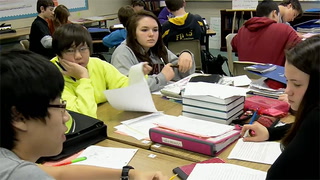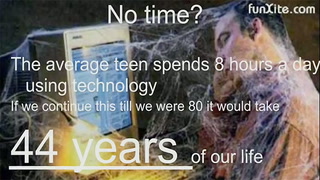TIMECODE SOT NOTES / TEXT ON SCREEN
00:00:00 JULIE MANLEY: My name is Julie Manley. I teach eighth grade language arts at Chinook Middle School in Bellevue, Washington. TEXT:
Julie Manley
8th Grade ELA Teacher
Chinook Middle School, Bellevue, WA
00:00:11 JULIE MANLEY: In the next two lessons, I am going to ask students to analyze and write and present persuasive speeches. TEXT:
Common Core: Speaking, Listening, and Speech Presentations
00:00:17 JULIE MANLEY: So, at the beginning of the lesson, I wanted the kids to think about what they already know about argumentative writing. So, I asked them to brainstorm those elements.
00:00:27 JULIE MANLEY: I'm going to have you guys conduct a brainstorm and do that through quick writing and that is because I want to see where you are in just knowing the elements of argumentation without looking at the rubric right now. So, somebody with a nice, loud voice read the question. Christoph? TEXT:
Ask students to brainstorm and quick write
00:00:42 CHRISTOPH: What makes an effective, persuasive text? TEXT:
Text = Transcribed Speech
00:00:45 JULIE MANLEY: Perfect. Thank you.
00:00:46 JULIE MANLEY: Write as much as you can in two minutes. Go.
00:00:51 JULIE MANLEY: During the brainstorm, I asked students to write down the essential elements of an argumentative speech that will prepare them for when they write their own speech, and I was satisfied they were all writing as a first step. TEXT:
Common Core: Write on demand and access prior knowledge
00:01:02 JULIE MANLEY: Let's hear from Will first.
00:01:04 WILL: I said a counter argument to support the other side of the topic. TEXT:
Counter-Argument
00:01:08 JULIE MANLEY: Awesome. And where should we put that Will?
00:01:11 WILL: We should put that over organization.
00:01:15 JULIE MANLEY: Yeah.
00:01:18 GIRL: I said that you need to make a poignant claim that you can credibly backup with logic and reason. TEXT:
Poignant claim
00:01:25 JULIE MANLEY: I love the word, poignant, and I've actually used it once today. Will you tell your peers what you mean by that?
00:01:31 GIRL: It means emotional, so that would be ethos, or pathos I mean.
00:01:37 JULIE MANLEY: I was excited when I saw students able to talk about a variety of argumentative elements. They gave some examples for their ideas of a persuasive topic, what is needed, the claim, and reasoning and evidence.
00:01:51 BOY: I said that it has to have rhetorical devices such as anaphora and parallel structure. TEXT:
Rhetorical Devices
00:01:57 JULIE MANLEY: The next part of the lesson, I transition students into reading a model text of a persuasive speech, to look at that speech to analyze its argumentative elements. And, then, take that information into writing their own outline. TEXT:
Next: Delineate a Speaker’s Argument
00:02:13 JULIE MANLEY: I want you to pay attention to what this student is doing well that you already do well. And then what's that student doing that you're least comfortable with and really pay attention to that because you can mimic what this student is doing when you ultimately write yours.
00:02:28 JULIE MANLEY: I assigned each table group to read for a particular argumentative element. TEXT:
Assign each group an argumentative element
00:02:34 JULIE MANLEY: Just take a look up here because when I say group one through group six, I don't want to read what you are looking for. So, once I say it, you guys confirm with other, like, oh, okay, we're looking for this. So, you guys are going to be group one. You guys are group two. TEXT:
Group #1
Claim/reasoning/evidence
Group #2 – recognizing opposing claims
Group #3 – appeals (logos, ethos, pathos)
00:02:48 JULIE MANLEY: You guys are three. So, I'm going to read aloud the first paragraph you guys marked for your assigned topic as we go. So, healthier lunches, I step into the cafeteria and make my way over to the lunch line. TEXT:
Common Core:
Delineate a speaker’s argument and specific claims
00:03:00 JULIE MANLEY: I get into the line. As I get closer to getting my lunch, I see the variety of lunches I'm stuck with.
00:03:08 JULIE MANLEY: I ask students to be listening as I read aloud and also be marking the text for evidence, textual evidence that they could locate to support their element.
00:03:20 JULIE MANLEY: Already, what are we noticing?
00:03:24 BOY: How it keeps being rhetorical with the words he's using.
00:03:26 JULIE MANLEY: Linnea, you had an idea.
00:03:28 LINNEA: She uses an anecdote to get the point across. TEXT:
Common Core:
Students engage effectively in discussion
00:03:33 JULIE MANLEY: Generally, I was impressed by students' ability to pick out all of the argumentative elements.
00:03:39 JULIE MANLEY: What other examples did you notice?
00:03:40 BOY: At the bottom of the page where it says most other kids get this too, that was a little bit of parallel structure right there because they're listing out what the kids don't eat. And then, like, throughout the second paragraph, there's a lot of imagery. TEXT:
Parallel structure
Imagery
00:03:54 GIRL: We noticed that this author wasn't using a lot of pathos or commentary, but they used a lot of logos. TEXT:
Logos
00:04:02 JULIE MANLEY: There's something also missing you guys. There's missing big time that, Len [sounds like], some of this logos we could say is faulty. What's missing? What do you know you need to have when you are trying to prove your claim with sound reason and really great evidence?
00:04:19 BOY: He could add in, like, a source of where he got his information. TEXT:
Add Source
00:04:23 JULIE MANLEY: You guys, everyone write this down as big. Add source or citation. That's huge.
00:04:29 JULIE MANLEY: The last step of the lesson was a reflection opportunity. I wanted students to think about what were they noticing in that essay and how did that apply to me.
00:04:38 JULIE MANLEY: I want you to be able to think of some be sure to's. Now that you've just read this model essay, what should we be sure to do or not do. We can even think about it like that. And that will help you write your outline as homework tonight. Talk to each other and then I'm going to ask.
00:04:56 BOY: No, like, with a lot of evidence.
00:04:58 GIRL: Should have more of these.
00:05:00 BOY: Yeah, that's basically the key point because... TEXT:
Add evidence and ethos
00:05:03 GIRL: ...logos to [inaudible]...
00:05:03 BOY: ...just to add ethos.
00:05:05 JULIE MANLEY: You guys, let's hear at least one do or don't before we pack up. So, please don't pack up. Let's hear one do or don't. And you know what? I'm going to do bring us back to this because this was my purpose, to have you think about what makes an effective.
00:05:17 JULIE MANLEY: Now, looking at a fairly effective speech, at least a portion of it, what should we remember to do or not do?
00:05:22 JULIE MANLEY: Jung Woo [sp] and then I'm going to call on Mary. So, Jung Woo, why don't you go first?
00:05:29 JUNG WOO: Okay. From, like, from paragraph B, like, the person, like, repeated of himself and stuff. So, we shouldn't do that. Like, don't bore…
00:05:37 JULIE MANLEY: Although, we know repetition can be effective if you're really trying to drive home your point. But don't do it so much that it makes your audience fall asleep. I like it. I like it. Mary, a do or a don't do. TEXT:
Use Repetition Effectively
00:05:49 MARY: I think it's really important to use appeals, like the way, like logos ethos and pathos. TEXT:
Use Appeals
00:05:56 JULIE MANLEY: I like it. So, you guys, your homework tonight is follow that outline form and incorporate these ideas and we'll see where we are tomorrow.
00:06:05 JULIE MANLEY: One small group, students were addressing the speaking and listening standard of evaluating an author's argument. TEXT:
Tch Classroom Takeaways:
Common core
Speaking and listening:
Delineate author’s arguments for claims and sound reasoning
00:06:12 JULIE MANLEY: And so, the activity of reading a print text of a speech allowed them that opportunity to be thinking about that speaker's claim, reasoning and evidence, and then if it was successful or sound.
LOGO:
Tch TeachingChannel













14 Comments
Michelle Brown Apr 29, 2019 12:41am
I would also like to know which speech you are analyzing. Great lesson :)
Deborah Lessa Nov 11, 2017 9:27pm
ananya koyada Nov 27, 2016 12:40am
Cindy Downing Feb 12, 2015 11:53pm
Muna Abdallah Jul 28, 2014 10:39am